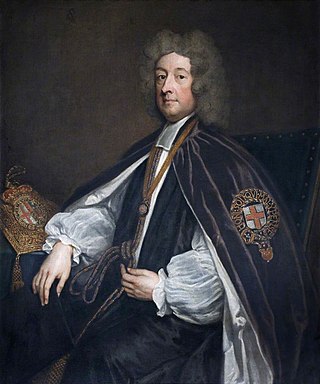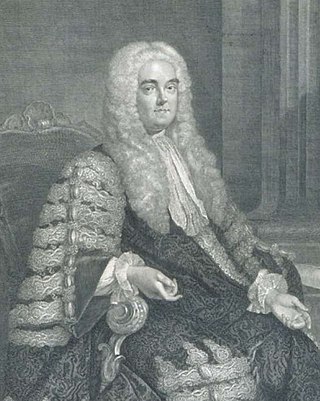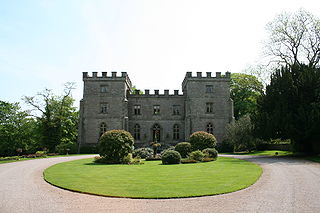Related Research Articles
Lacy Ryan, English actor, appeared at the Haymarket Theatre about 1709.
This is a timeline of the history of piracy.

William Talbot was an English Anglican bishop. He was Bishop of Oxford from 1699 to 1715, Bishop of Salisbury from 1715 to 1722 and Bishop of Durham from 1722 to 1730.

Kilian Ignaz Dientzenhofer was a German Bohemian architect of the Baroque era. He is among the most prolific and renowned architects of his era in Bohemia. He was born into the well known Dientzenhofer family of architects and is considered its most talented and productive member.

Robert Raymond, 1st Baron Raymond, was an English judge, politician and peer who sat in the British House of Commons between 1710 and 1724.

Johann Baptist Zimmermann was a German painter and a prime stucco plasterer during the Baroque.
Sir William Thompson of Middle Temple, was an English judge and Whig politician who sat in the House of Commons between 1709 and 1729.
Thomas Lumley-Saunderson, 3rd Earl of Scarbrough, KB was a British peer, British Army officer and diplomat.
Sir Edmund Bacon, 5th Baronet, of Gillingham, Norfolk, was a British Whig politician who sat in the House of Commons from 1722 to 1738.

Sir John Verney, of Compton Verney, Warwickshire, was a British barrister, judge and Tory and then Whig politician who sat in the House of Commons from between 1722 and 1741.
Denis Bond (1676–1747), of Creech Grange, Dorset, was English lawyer and Whig politician who sat in the House of Commons between 1709 and 1732, when he was expelled for financial misconduct.
Noel Broxholme, M.D. (1686–1748), was an English physician.
Thomas Sclater, later Thomas Bacon, was an English lawyer and Tory politician who sat in the House of Commons at various times between 1713 and 1736.

Joseph Smith (1670–1756) was an English churchman and academic, Provost of The Queen's College, Oxford, from 1730.
Richard Sutton, of Scofton, Nottinghamshire, was a British Army officer who fought in the War of Spanish Succession, and a politician who sat in the House of Commons between 1708 and 1737. He was primarily a Whig, but on occasion voted as a Tory.
Sir Edward Simpson, of Acton, Middlesex was an English politician, lawyer and academic.

Thomas Wyndham of Clearwell Court, Gloucestershire, Dunraven Castle, Glamorgan, and Cromer, Norfolk, was a British lawyer and politician who sat in the House of Commons from 1721 to 1734.
Charles Bathurst of Clints and Skutterskelfe, Yorkshire was a British politician who sat in the House of Commons briefly from 1727 to 1728
Anne Parker (1696–1740) was a British stage actress of the eighteenth century. She is also known by her married names Anne Berriman and Anne Hallam.
References
- ↑ Admissions Register VOL 1 1420-1799. The Honourable Society of Lincoln's Inn. 1896.
- 1 2 "Sayer, Exton (SR709E)". A Cambridge Alumni Database. University of Cambridge.
- 1 2 3 "SAYER, Exton (c.1691-1731), of Doctors' Commons, London". History of Parliament Online. Retrieved 2 January 2019.